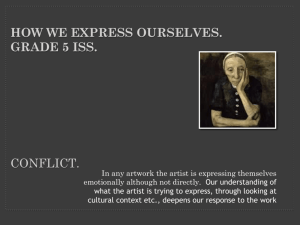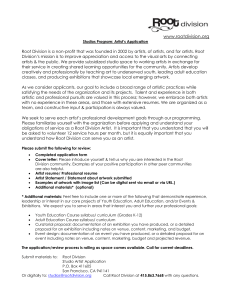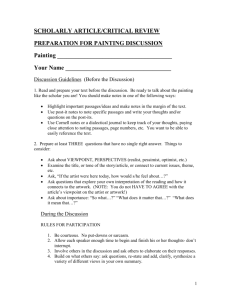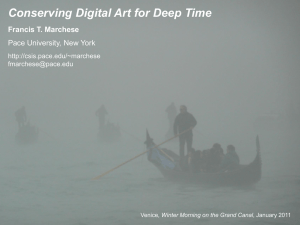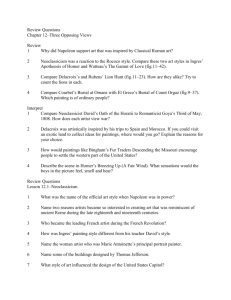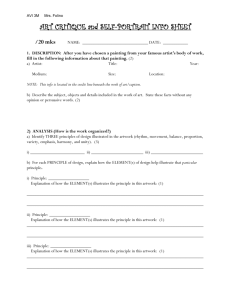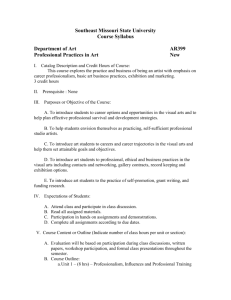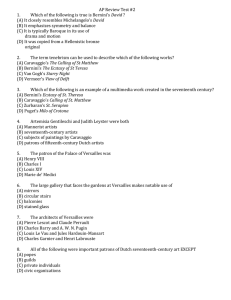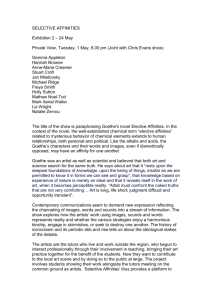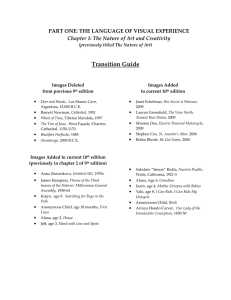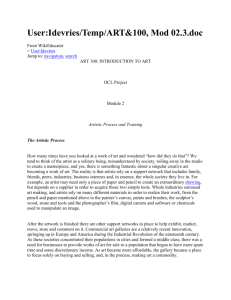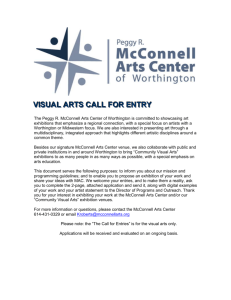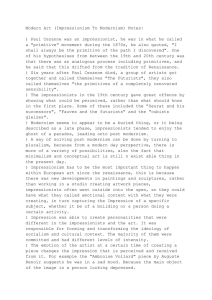Digital Art: Is that Art Miss
advertisement
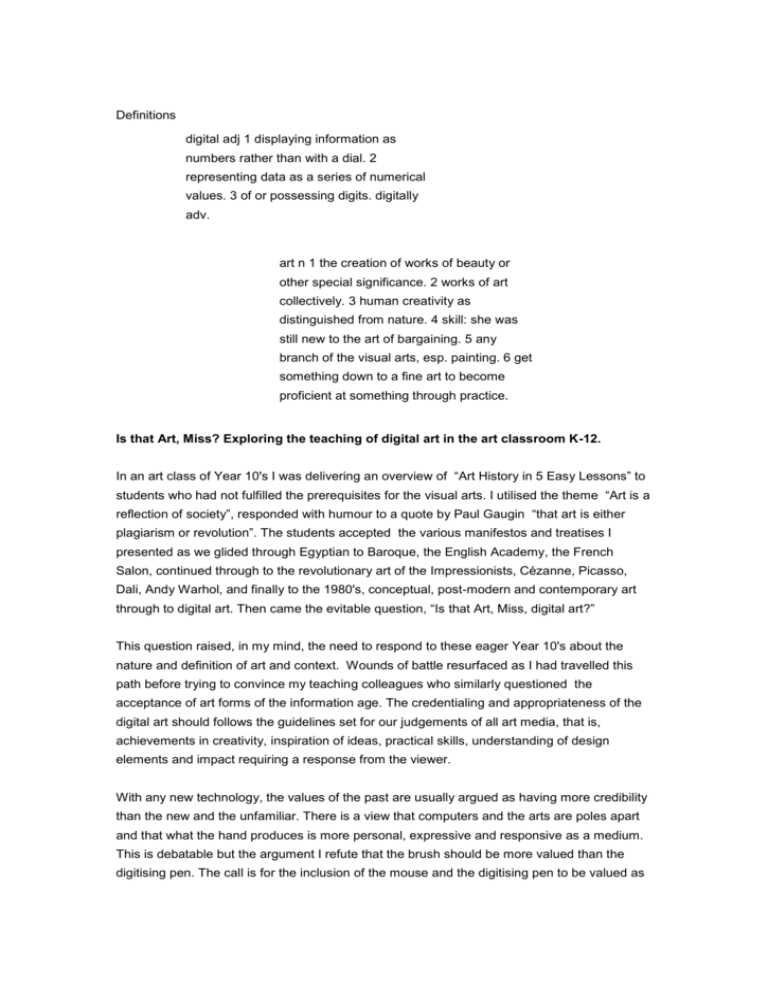
Definitions digital adj 1 displaying information as numbers rather than with a dial. 2 representing data as a series of numerical values. 3 of or possessing digits. digitally adv. art n 1 the creation of works of beauty or other special significance. 2 works of art collectively. 3 human creativity as distinguished from nature. 4 skill: she was still new to the art of bargaining. 5 any branch of the visual arts, esp. painting. 6 get something down to a fine art to become proficient at something through practice. Is that Art, Miss? Exploring the teaching of digital art in the art classroom K-12. In an art class of Year 10's I was delivering an overview of “Art History in 5 Easy Lessons” to students who had not fulfilled the prerequisites for the visual arts. I utilised the theme “Art is a reflection of society”, responded with humour to a quote by Paul Gaugin “that art is either plagiarism or revolution”. The students accepted the various manifestos and treatises I presented as we glided through Egyptian to Baroque, the English Academy, the French Salon, continued through to the revolutionary art of the Impressionists, Cézanne, Picasso, Dali, Andy Warhol, and finally to the 1980's, conceptual, post-modern and contemporary art through to digital art. Then came the evitable question, “Is that Art, Miss, digital art?” This question raised, in my mind, the need to respond to these eager Year 10's about the nature and definition of art and context. Wounds of battle resurfaced as I had travelled this path before trying to convince my teaching colleagues who similarly questioned the acceptance of art forms of the information age. The credentialing and appropriateness of the digital art should follows the guidelines set for our judgements of all art media, that is, achievements in creativity, inspiration of ideas, practical skills, understanding of design elements and impact requiring a response from the viewer. With any new technology, the values of the past are usually argued as having more credibility than the new and the unfamiliar. There is a view that computers and the arts are poles apart and that what the hand produces is more personal, expressive and responsive as a medium. This is debatable but the argument I refute that the brush should be more valued than the digitising pen. The call is for the inclusion of the mouse and the digitising pen to be valued as a credible tool for making art. The critique of an artwork is based on the development of skills and knowledge, aesthetic criteria and the effective impact of the image. Where does digital art lie as an art form. Are we too close participating in the epoch of the now to measure the value, the essence of this new evolutionary style. How does this impact on art education where traditional art movements and media dominate. Computer Art is a broad term, and assumes all work is created on the computer. The digital artistic revolution spans a wide spectrum from 3D fantasy landscapes to straight digital photography. The fine arts can be categorised into areas of specialisation of painting, drawing, ceramics, photography, printing and sculpture so too digital arts covers the gamut of 2D and 3D computer arts, digital painting, animation, multimedia, sound, theatre, performance and so on. For the student, the arts is an area that has always required creativity. With the advent of computers this creativity provides a new outlet. Students can look to many traditional masters for inspiration and the explosion of multidisciplinary technologies in arts and sciences showcase the infinite possibilities of the medium. Artists using computers have the potential to generate new revolutionary forms of art. The Australian Centre for Arts and Technology, Canberra, offers courses encompassing diverse areas such as computer animation, digital video, interactive multimedia and computer music. ACAT state that digital technology advances the lines between different disciplines and genres are becoming increasingly blurred. Jenny Grenfell, a lecturer in Visual Art Curriculum, Deakin University, states that without an appropriate pedagogy, computer use cannot provide for planned, significant learning outcomes in students. In general it is the pedagogy that provides for learning in students not the computer software alone. The skill set required of the digital artist has broadened as genres redefine and mingle. Today's digital artist requires a firm grounding in digital imaging, digital sound production, Internet technologies, critical theory and cultural context.” The interactive multimedia stream is a sequence of study that will deal with various modes for producing and presenting art that incorporates a range of digital media. These modes will include disk-based works, online works and multimedia installation and performance works. The discourses on the differentiation between form and function continue, between an art form being art for art’s sake as distinct of a display of fine craft or a commercial product. My involvement in the digital art goes back to 1980 when I used first an Apple Macintosh, MacPaint and a video capturing software. Art teachers, generally speaking in 2002, are slowly embracing digital media as part of their toolset for art making. General misunderstandings of the role of computer as a tool and medium for expression can be make it hard to convince some art teachers to develop an enthusiasm for the computer. Utilising a computer for teaching will not result in surrendering to the teaching and learning process. There are several reasons for the slow uptake of teachers in both the primary and secondary sector which range from an lack of skill with general computer technology, the learning curve is exhaustive and never ending, the inability to problem solve when technology lets you down, the teacher is not seen as master of the new technology, the need for expensive computers to run computer graphics, computers in a general art classroom are not suitable in a practical art area are constant rationales for slow uptake and the fear of the unknown. Consequently, art classes require a computer away from the practical art area to avoid the traditional 'messy' art making methods. The clean and industrial modes of digital art disregards the d'esprit de corp of the creation process intrinsic to the natural traditional disciplines of painting, drawing and sculpture. Art students and teachers still crave the tactile experience provided by more traditional art forms. Can the natural media programs such as “Painter” and “Deep Paint”, “Photoshop” ever achieve this experience? Evidence of the slow uptake of the digital medium is reflected at the latest Top Arts 2002 at the National Gallery of Victoria and the Art Express Exhibition at the National Gallery of NSW. Both of these exhibitions display contemporary, innovative and exploratory, exhibition the works of senior Art and Studio Arts students selected from Government, Independent and Catholic schools. Less than ten percent of artwork selected for exhibition showcased art created totally or in part with a computer. An example, “Liberate to a perfect place” (48 x 70.5 cm) by Leah Robertson, Bayside Christian College, Baxter, is a large inkjet print. The artist states, “I wanted to shock, disrupt and disturb my audience”. A smaller component of mixed media, for example, “Just Like Anyone” (143 x 244 cm) by Charlene Loh from Catholic Regional College, Sydenham utilises a combination of inkjet printing, synthetic polymer paint, shellac, paper, varnish, computer keys on board. Charlene states, “I wanted to comment on individuality vs conformity”. Both young artists have utilised the digital medium successfully as a form of artistic expression. The promises and demands of the 21st century require today's students to live and work in a rapidly changing technological society. Through comprehensive arts education, students are better educated and more prepared to succeed in this challenging environment. Students of the fine arts learn to perceive and respond to the world with increased awareness, discerning judgement and the ability to pair appropriate applications and process to product and output. The vision of the Digital Arts Task Force of the Texas Arts Network, in the USA, is based on the belief that through new technological innovations, infrastructures and partnership the arts now have the potential to advance enhanced professional development opportunities in arts technology integration, an understanding of new research linking arts technology education to overall student achievement and promotion of "best practices" and models for technology in arts education. Those who has seen the animated film "Monsters Inc.," played a video game, or browsed the web has experienced technology's profound influence on popular culture says Fernando Quintero, lecturer, Teaching and Learning Technology Centre, University of California. As we rapidly shift to technological forms of creative production and communication, art and society are being transformed in ways we are just beginning to comprehend. Understanding how the ever-shifting nature of technology is changing the practice and study of the arts is among the many challenges being met by art teachers, who can be on the leading edge of the emerging field of digital arts. Like the technology it incorporates, this discipline is evolving at the speed of light - and heralding profound changes in a cross-section of academic areas. From hyper-media theatre performances to digital video, from molecular music to transgenic art, the field of digital arts is defining itself as it goes along. Back to my Year 10 art class. I proclaim that digital art is one of the newest art forms, which will change art forever. We looked to the example of Stellarc, a contemporary Australian artist of notoriety for his computer-generated art who combines performance with computer technology. In a performance a few years ago his nerves were hooked up to the Internet, being controlled by the pulses generated by search engine hits. At the same time this artwork is merely an extension of the works Stellarc performed with his own body during the 1970's. So what about the new possibilities of digital art to visual expression? One direct benefit from digitality is the infinite editability, and with the ability to "undo" option you can try and try again until you get all the individual brush strokes or other editing steps the ideal way you want. This might result into more "perfect" images than possible with conventional means. Of course, the pursuit for perfection is a tenet of various past art theories. Digital art meets this constant, artistic value of perfection, the old battle between the form and the content. Modernists purport that images of beauty distracts the brain from the content. Today, the art world seems quite fragmented, no uniform ideals or goals, so how should it view the perfected images of the digital medium? Is content still required? And what kind of content is needed, if any? Is the mystery factor essential for “fine art”? If these questions peak your interest, look up the last 5 winners of the prestigious Turner prize in England. Art in the 21st century will change like never before seen in history. As our cultural expressions become more embedded in current technologies, the need for the current technologies is necessary to see how we as a culture express ourselves. Artists working in digital media cannot plan for the advances that could take place in future years? Will imagery become obsolete? Will, as Alvaro, a digital artist, theorises, “Digital media will replace traditional media, and then traditional media will become art.” Fine art in its traditional has no future? The only truly defining statement I have found comes from Laurie Smith, an Australian artist, which seems to cover it all is “Art is what artists do”. Renee Hoareau Renee Hoareau is currently the Education Services Manager for myinternet Limited. Renee has a teaching background in the Arts and Information Technology and is an enthusiast for the integration and advancement of Technology and the Arts.

